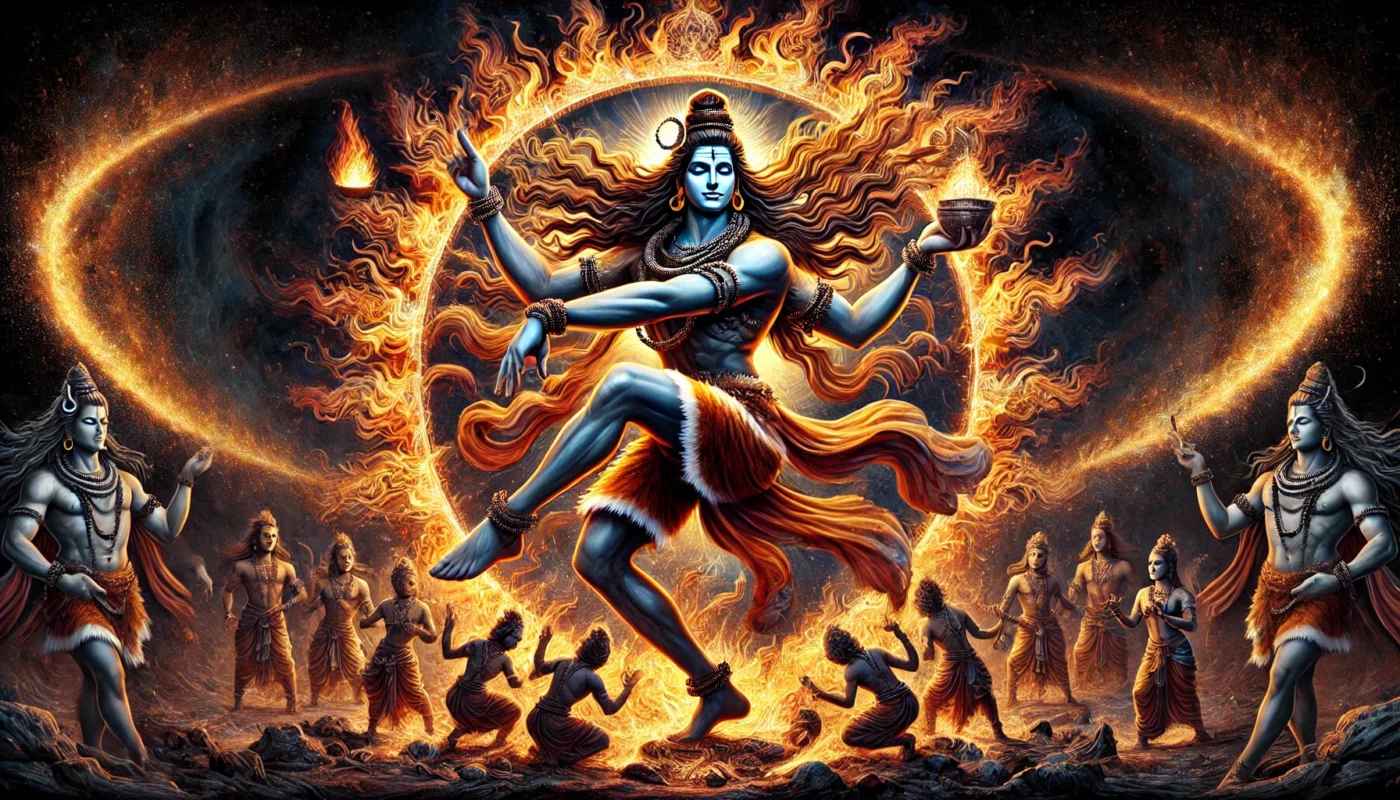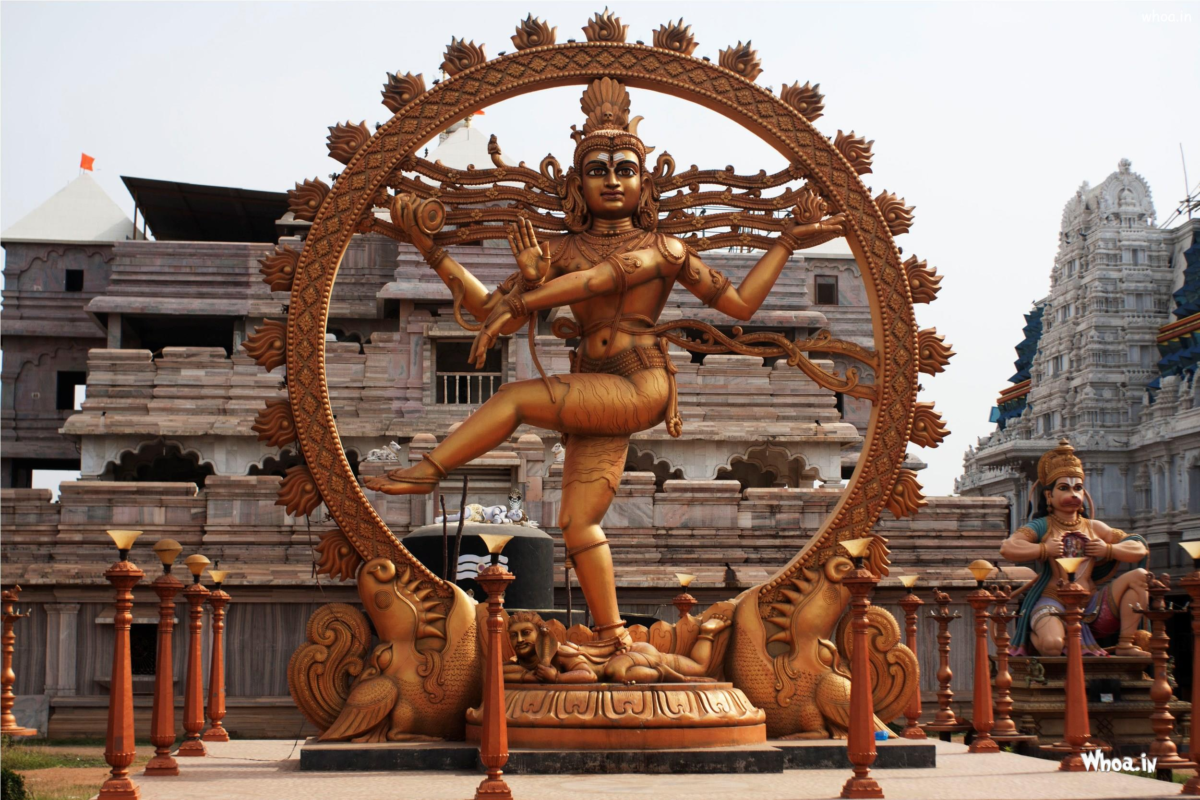According to Hindu religious scriptures Lord Shiva is considered as the most important and powerful god among the Trimurti (the trinity of Brahma, Vishnu, and Shiva). The scriptures mention various roop (forms) and leelas (divine plays) of Lord Shiva. It is believed that the nature of Lord Shiva is as simple and gentle as it is fierce, hence one of his names is Bholenath (the innocent one) and another is Rudra (the fierce one). Shiva is also referred to as “avinadhi” (indestructible). Devotees also call Lord Shiva by many other names such as Mahadev and Shankar. Similarly, Lord Shiva is also known as Nataraja. Today, through this article, we will learn about the Nataraja form of Lord Shiva.
Table of Contents
Meaning of Nataraja
The term Nataraja can be broken down into two words: “Nat” meaning ‘act, drama, dance,’ and “Raja” meaning ‘king, master,’ thus Nataraja means ‘the king of dance,’ i.e., the one who performs the supreme dance.
It is said that when Lord Shiva is happy and in a joyous state of mind, he performs a gentle dance. He performs this gentle dance often with his wife Goddess Parvati or during the creation of the universe. However, Lord Shiva’s dance also has a fierce and terrifying form which he performs during the destruction of the universe. This fierce dance of Lord Shiva is called Tandava. In the Ramayana, Ravana, the king of Lanka who was also a great devotee of Shiva, described this Tandava dance in his hymns, known as “Shiva Stotram” or “Shiva Tandava Stotram.”
Origin of Lord Shiva Nataraja Form
According to some locals there is an interesting story behind Lord Shiva’s Nataraja form. The story goes like this. In a dense forest in South India, many heretical sages lived who were consumed by a demon Apasmara. To defeat this demon, Shiva decided to go there, accompanied by Lord Vishnu in the form of a beautiful woman. As the sages were under the influence of the demon they started quarreling over the woman, but soon their anger turned towards the man who was with this woman, and the sages tried to destroy him through their mantras.
The sages created a ferocious tiger from the sacrificial fire, which jumped and attacked on Shiva. However, Shiva, smiling, skinned it with his little finger and wrapped the skin of the tiger around himself as an attire. Undeterred, the sages doubled their sacrifice and created a giant serpent. However, Shiva again wrapped the giant snake around his abdomen. Then Shiva started beating his damru (drum) and began to dance. Getting angry by the sound waves produced by the damru, the demon in the form of a wicked dwarf attacked him. Shiva crushed the dwarf under his foot, breaking its back and causing it to writhe on the ground.
Shiva didn’t kill the dwarf demon; he just kept him under his feet. With his last enemy defeated, Shiva resumed his dance.
Know the story behind fasting on Monday to please Lord Shiva
How does Nataraja form of Lord Shiva looks like?

The very first depictions of the Natraj form of Lord Shiva can be seen in a beautiful series of South Indian bronze sculptures which are said to be the time between 10th and 12th centuries CE. In these sculptures, Nataraja can be seen in a dancing state with his right foot on a bent figure and his left foot gracefully lifted. A snake which is tied through his abdomen can also be seen, and on his head is a crescent moon. He dances within a circle of flames.
As a 80’s or 90’s kid we must have seen Natraja form of Lord Shiva on the packaging of popular Indian HB pencil brand which sells its products with the same name i.e., Natraj. Back then it was a belief that if we’ll add anything religious to a brand then it’s chances of becoming popular among the masses would increase and that is the reason we have a stationery brand with the name Natraj.
There are many representations and depictions of the Nataraja form of Lord Shiva however, the most common depictions show Natraj with four arms. These arms represent the four directions. Each hand either holds an object or forms a specific gesture (mudra).
Natraj forms’ major symbols and their meanings:
- Upper right hand: The upper right hand of Natraj holds a drum (damaru), symbolizing the sound of creation. The sound from the damaru also provides music for this dance.
- Upper left hand: This hand holds fire, symbolizing destruction and renewal.
- Lower right hand: This hand makes abhaya mudra (gesture of fearlessness), indicating that Lord Shiva grants freedom from fear.
- Lower left hand: This hand points towards the raised foot, symbolizing liberation and upliftment.
- Right foot: Natraj’s right foot is depicted balancing itself on the body of a dwarf, which according to mythology and folklore, represents a demon ‘Apasmara’.
Some Interpretations behind Nataraja Form

In Ayurveda, Apasmara is a concept of a disease where memory loss is seen as a symptom. In Hindu mythology, Apasmara represents spiritual ignorance and meaningless speech and that’s why when the sages came under the influence of Apasmara they forgot their heretical deeds and started wanting materialistic things. Lord Shiva’s act of crushing this demon under his foot symbolizes his victory over ignorance.
According to some great interpretations the circle of fire and light surrounding Natraj form represents the universe. As fire is a symbol of destruction and renewal therefore, this circle symbolizes the cycle of creation, preservation, and destruction, reflecting the constant change in the universe.
The snake coiled around Shiva’s waist in the Nataraja form represents Kundalini, the divine energy believed to be present in all beings and which can also be awakened even by ordinary humans by doing yoga and meditation. The intensity of Shiva’s Tandava dance is such that his hair, usually tied in matted locks, loosens and spreads out in all directions.
In the Nataraja form, a small figure of the river goddess Ganga is shown nestled in Shiva’s locks. It is believed that when the Ganga descended from heaven to earth everyone became fearful as the force of the flow of Ganga was such that it could have destroyed the surface of the earth; however, Shiva being the supreme power, captured her in his matted hair locks to moderate her powerful flow and prevent the destruction of the earth.
Upon observing carefully it can be seen that Lord Shiva’s face remains calm and composed as he performs the dance of creation and destruction, signifying his state of perfect balance and neutrality.
In Natraj form, Shiva’s dance represents the cosmic cycle of creation, preservation, and destruction. His Tandava dance symbolizes the continuous and repetitive nature of the universe.
There is also a mantra for meditating Lord Shiva in his Nataraja form:
“Angikam bhuvanam yasya vachikam sarva vangmayam। Aharyam chandra taradi tam namah satvikam shivam”
Meaning: We bow to the virtuous Lord Shiva, whose body is the universe, whose speech is the essence of all languages, and whose ornaments are the moon and the stars.








2 Comments
Comments are closed.